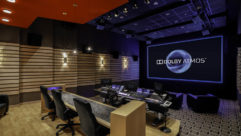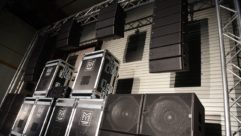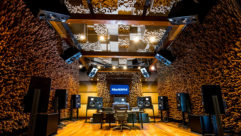
InfoComm 2012: Pro Audio
Jun 5, 2012 11:30 AM,
By Mike McIntyre
Some must-see audio products at this year’s show.
InfoComm 2012

Martin Audio MLA Compact
In this article I have featured a few new pro audio products that will either be debuting at InfoComm or have recently been introduced and are worthy of your consideration while on the show floor. There are many options those who are hungry for great audio products, so let’s dig in.
Line Array Loudspeaker Systems
For installed applications, Martin Audio is introducing the new MLA Compact. This series is built on the groundbreaking MLA cellular systems. Weighing in at a svelte 109lbs., this compact (31”x11”x9.6”) is reported to pack a heavyweight punch. Up to 24 enclosures can be suspended via its two-point-lift flybar. In the promotional material, Martin states that a 12-box array can easily deliver full rock SPLs in a 5,000-seat venue, while a 24-box array will approach the output of many full-size systems—which have less efficient acoustic elements.
The MLA Compact’s internal 5-channel Class D amplifier (2.1kW continuous) is divided up to power the LF drivers in parallel; two channels drive the MF loudspeakers independently, and the four HF drivers are powered by the last two amplifier channels, giving each box five powered acoustical cells. Add the realtime control to each of these channels in each enclosure and you have the magic—ok, science. The MLA Compact series is controlled using VU-NET control software from the supplied wireless tablet, from which the user may switch on enclosure identification LEDs with automatic identification of neighboring enclosures and connectivity confirmation.
I first became aware of Outline when I read about the famous 2008 Foo Fighters concert at Wembley Stadium in London. Outline has been building its line for several years and is now branching out into a compact line array system designed for small-to-medium-sized touring and installed applications. The Eidos 265 LA is a two-way passive loudspeaker line array element with an internal crossover. With a nominal impedance of 8Ω, up to four cabinets can be powered from a single channel of Outline’s T5-DSP amplification. The HF assembly is located in the center between the mid-woofers. Nominal horizontal dispersion is reported to be 100 degrees, and the vertical dispersion said to be wide enough to create predictable coverage when used in a curved configuration. The suspension hardware integrated into these mighty-mites is lightweight and simple. Array angles are selectable from 0 degrees to 10 degrees with a 1-degree step, and up to 16 enclosures may be flown in a single array. The cabinets are built from high-quality birch plywood and available in RAL specified colors, allowing them to fit with most décor.

Renkus-Heinz IC2
Renkus-Heinz started in the line array marketplace from a different angle, pardon the pun, than the previously mentioned companies. In most other solutions, column-type systems contain groups of 4in. loudspeakers designed for situations where aesthetics dictate the solution. The new IC2 is a slight departure from that theme. Each of the IC2 FR enclosures has four 8in. loudspeakers and four 1in. HF drivers powered by an internal 8-channel amplifier. With a horizontal dispersion of 90 degrees or 120 degrees and vertical opening angles from 10 degrees or 80 degrees, the IC² digitally steerable loudspeaker system has the ability to produce a very focused, in-your-face sound. Since these arrays may be steered electronically, they can be mounted flat against a wall or dead-hung in a straight line. Renkus-Heinz uses the same time-tested RHAON software that is in its groundbreaking Iconyx line, along with BeamWare that uses FIR filters to control the array’s coverage beams. Analog audio, AES, and CobraNet inputs make these cabinets highly versatile along with a powerful DSP inside each loudspeaker. The DSP includes eight bands of parametric EQ, high and low frequency shelving filters, input level control, muting, and up to 340 milliseconds of delay.
The column-type arrays have been used for years as a way of focusing audio to cover areas that you want to hit and to miss those that you don’t want to excite. Like the previously mentioned systems, the TannoyQFlex uses an onboard multichannel amplifier and DSP. What is different about this product is the ability to create an asymmetrical pattern, allowing a similar SPL in the near and far fields. Using the BeamEngine software, you can specify target areas and a steering algorithm is created to maximize coverage in those areas. This is different from most line array steering packages where you choose beam sizes and angles and wait to hear the results. The series was recently upgraded to deliver more resolute safety and monitoring facilities, making it fully compliant in any life-safety or mass-notification environment. Key improvements on this front are the addition of Pilot Tone Detection capability, Sentinel SM1 System Monitor, and certification to IP53 standards. They have also been weatherized for outdoor or harsh environments.
Thus far, I have explored electronically steered line array systems, but new to Tannoy is an alternative solution, the VLS series. It is a passive device offering balance of performance and cost when active beam steering may neither be required nor affordable. In practice, this type of solution is very effective when you can mount the loudspeakers in a good location relative to where they will be heard—a very old and well established technique. The VLS series is the first Tannoy product to incorporate Focussed Asymmetrical Shaping Technology (FAST), delivering unique acoustic performance benefits including asymmetrical vertical dispersion, gently shaping the coverage toward the lower quadrant of the vertical axis. Available models include the VLS 7, VLS 15, and VLS 30—all available in custom RAL finishes. Because these arrays are passively steered, you need help on the front end deciding where they should go. Voilà: EASE Focus v2.0 software, a generic, intuitive, and easy-to-use three-dimensional acoustic simulation software that is a simple, free download away.
InfoComm 2012: Pro Audio
Jun 5, 2012 11:30 AM,
By Mike McIntyre
Some must-see audio products at this year’s show.
Subwoofers
The next section in our buffet includes the beef, or the RLF—really low frequencies. Over the past 10 to 15 years, this technology has vastly improved. The amount of RLF you could bring to bear in a venue used to be directly proportional to how many large speakers in large boxes running on large amplifiers you could fit in the space and the budget. Below are just a couple of products in the brave new world of subs. As mentioned above, Outline will be introducing the Eidos 265 LA line array system at the show. The company’s complementary product FlySub 15 and FlySub 15 iMode will round out the low frequencies. A single 15in. bass reflex loudspeaker will be loaded into this finely tuned, small-but-efficient cabinet. One of the features of the cabinet is the oblique baffle on which the loudspeaker is mounted, which gives the transducer a secondary loading, improving the overall tone quality. With max SPL ratings into the 130s, they are a hefty addition to the MF/MF line array for which it was intended.

Meyer Sound 1100‑LFC
From the most well-known family-owned company in the audio biz, Meyer Sound, the 1100‑LFC low-frequency control element is a self-powered loudspeaker defined by its sonic linearity in reproducing low-frequency transients at high, continuous levels with very low distortion. Something that all of us have learned over the years is that distortion, harmonic and otherwise, can really color the sound we hear coming from a loudspeaker system in a negative way. Meyer has always been a leader in building products with minimal distortion and maximum headroom. A 2-channel Class AB/H bridged amplifier with complementary MOSFET output stages supplies ample continuous and peak power to the drivers. The amplifier, control electronics, and power supply are integrated into a single, rear-mounted module that is field replaceable. The 1100-LFC is engineered to integrate smartly with line arrays and curvilinear arrays comprised of Milos, Micas, and JM‑1Ps. Protective, plastic skids are included on the bottom of the 1100‑LFC cabinet that securely align with the cabinet’s top slots. Units can be stacked normally or reversed for cardioid configurations. A MRK-1100 rigging kit is available and includes captive GuideALinks that allow the loudspeaker to be flown from the MTG-1100 top grid, and also accommodate reversed units for flown cardioid arrays.
Digital Mixing Console
Although there is only one item in this category, this part of our buffet is chocked-full of nutrition for you audio appetite. A decade after the release of the D5 Live, DiGiCo launches its newest desk, the SD5. As you would expect, the SD5 fits directly into the D5s shoes, but it benefits from the advancements of the proprietary Stealth Digital Processing. Some of the incredible features on this console are: 124 input channels, 56 configurable buses plus master bus, 24 dynamic equalizers, DiGiTubes on all channels, 24 multiband compressors, 24 digital effects, 32 graphic equalizers, 24×24 matrix multichannel folding, and 10×4 (40) RGB backlit macro buttons, plus the ability to add a Waves upgrade. The SD5 work surface operates quietly and coolly, while offering a lot of visual information on five digitally driven, full color TFT LCD screens. As standard, the SD5 comes with a 2Gbps fiber-optic system, which is capable of running 448 channels of I/O at 96kHz, plus 56 console-to-console tie lines, allowing connection of up to 14 of the SD series racks. There are three redundant MADI ports and local I/O includes eight microphone inputs, eight line outputs, and eight AES I/O (mono).
Digital Signal Processing
For this stop at our buffet I explore a couple of new products that help us get the audio where we want it, the way we want it, when we want it. Maybe this is a lot like dessert, but these products are much more substantial than that. Biamp Systems will be showing its newest network media product Tesira. For systems that require a much larger capacity and scalability, Tesira is the first offering from Biamp that uses Audio Video Bridging (AVB) as the primary digital media delivery system. AVB is the new IEEE open standard that allows media streams to be carried over Ethernet networks using existing cable infrastructure alongside traditional data. Since these systems run off of multiple processors, they have added a feature whereby parts of the program may be configured and updated while other parts of the system are still operating fully. This product was a finalist in the 2012 AV Technology End-user Awards for Best Distance Learning Systems. System structure consists of the Server, Server-IO cards, expanders, and expander I/O cards. Other features include new processing algorithms SpeechSense and AmbientSense; a 4-channel acoustic echo cancellation card (also includes AGC and ANC); an ambient noise compensation card; and two new telephone cards—one for analog lines and the other for VOIP. All I/O cards have been updated and improved. This ambitious new product from Biamp looks to be an extremely powerful audio tool for years to come.
The Worcestershire, U.K.-based manufacturer XTA Electronics will showcase its new DS8000. From the famous family of the DS8000 mic/line distribution system, this device has undergone a complete redesign and is loaded with features. The DS8000 is an eight-input, 32-output audio distribution system. In default format, each input is split into two transformer-isolated outputs (-10dB level) and two actively balanced outputs, or it can be reconfigured internally to change the output distribution all the way up to 32 per single input. The inputs feature a remote activated pad, adjustable gain, mic/line switch, 48V phantom power, five-segment LED metering, and a listen facility. When using multiple units, the listen facility can be cascaded such that any input channel may be listened to via a single headphone output.

DPA Microphones d:fine
Microphones
The d:fine range of headset microphones is a cost-effective solution from DPA Microphones, long known for reference quality microphones. Features such as availability in single or dual-ear versions, an optional 4cm. short boom, and a detachable cable make these microphones an important part of any audio systems’ repertoire. Also on hand at the show will be the d:vote range of instrument microphones, which is based on the highly acclaimed 4099 instrument clip mic series. Features include an enhanced shock-mount design and a choice of detachable cables of two diameters and versatile gooseneck extender. The recently unveiled, handheld d:facto vocal mic, based on the DPA reference standard cardioid 4011 microphone, will also be on display for demonstration. This microphone should be a great bridge between live performance and studio recording. Features include extreme sound level handling, 154dB, a three-step pop-protection grid, suppression of handling noise, and impressive definition, accuracy, and zero coloration.

Audix M40
The M40 from Audix is a miniaturized condenser microphone with a fully integrated preamp designed with very high sensitivity for distance miking. This would be a nice fit for ceiling-mounted videoconferencing, distance learning, hospital rooms, surveillance, and ambient room miking. Excellent RF interference rejection means you never have to worry about cell phone and GSM device interference. It is available with a cardioid, hypercardioid, or shotgun capsules. For installations where plenum-rated cable is to be used, an optional nickel-plated metal junction safety box is available.
End of this buffet
There are plenty of items listed above of all different flavors to digest. Hope to see you all feasting along with me at InfoComm 2012.










